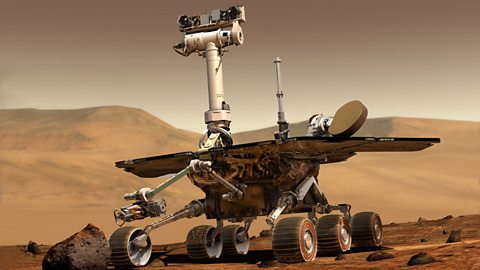Risks of space exploration
Space exploration can be a risky business. Space is a vacuum and humans cannot exist in a vacuum. This means that we have to create crafts and suits which provide an environment where humans can survive.
The risks involved with space exploration include:
- micrometeorites – danger from impact damage (to spacecraft and to astronauts during spacewalks)
- solar flares and radiation – danger from ionising radiations that could cause cancer
- no atmosphere – we need air to breathe and atmospheric pressure to stop our bodies decompressing
- temperature – space is extremely cold at -270.42 Celsius, far too cold for humans to survive without protection
- space debris – danger from impact damage
Watch the video to learn more about the dangers from an ever-increasing amounts of space debris orbiting the Earth.
Debris falling from space
The main danger in space comes from temperature. It can vary from being extremely cold (in shadow, not in line of sight of the sun \(-150 {^\circ}C\)) to very hot (in line of sight of the sun \(+120{^\circ}C\)). The suits and craft are designed to keep the environment at the temperature that we can live in – about \(20{^\circ}C\). So excellent cooling and heating systems are required in space.
If astronauts are in orbit then they are usually travelling very fast. The International Space StationCollection of modules constructed by several countries that currently orbits above the Earth at altitudes of 330km to 430km. A permanent space station. Eg: the ISS orbits Earth 15 times a day. orbits the Earth about 12-15 times a day. In space, with no air, this is not a major problem in terms of air friction.

However, on returning to Earth, the spacecraft will re-enter the atmosphere. While the air itself may not seem dense, travelling very fast through air creates very high frictional forces generating extremely high temperatures.
To protect astronauts from these high temperatures, the spacecraft must be able to:
- absorb a certain amount of heat energy.
- radiate heat energy back into the atmosphere.
Spacecraft have heatproof tiles on the underside. These protect the occupants from the high temperatures and prevent the spacecraft from being destroyed on re-entry. Re-entry temperatures can reach as high as \(1,650{^\circ}C\).

To manage the risk of space exploration with the need for further scientific information about space and other planets, we use robots such as NASA's Spirit rover to explore for us. These robots can be controlled manually but often run independently following pre-programmed instructions.